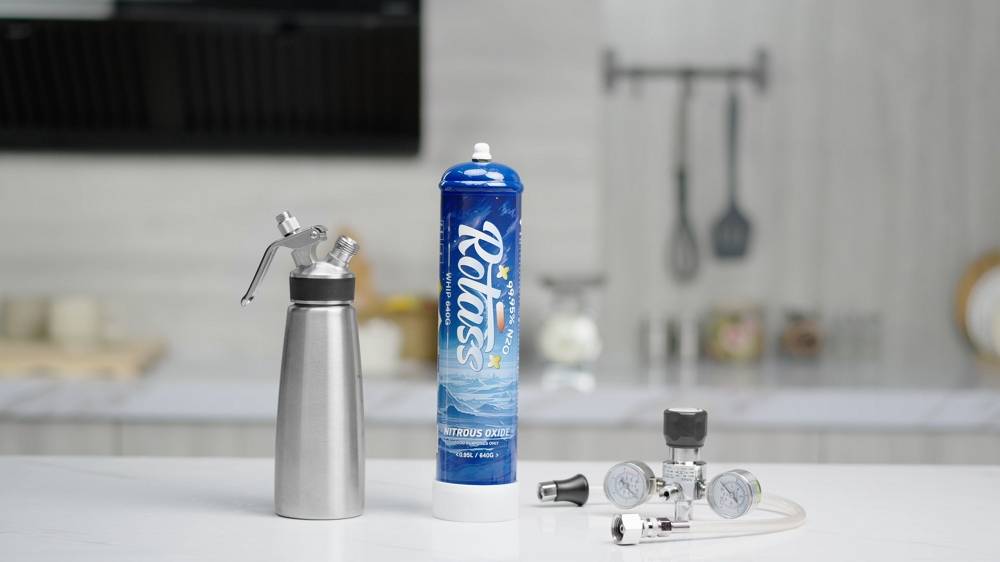2024 / 09 / 19
Flavor Additives for Nitrous Oxide Cylinders
Contents
In the food processing, N2O serves as a propellant and foaming agent, particularly in the creation of whipped creams, mousses, and foams. Utilizing a nitrous oxide cylinder allows chefs and home cooks alike to craft a variety of textures and flavors in their culinary creations. This article delves into the different flavor additives that can be used with N2O cylinders and provides essential tips for their effective and safe application.

Understanding Nitrous Oxide in Food Production
Nitrous oxide is a colorless, non-flammable gas that, when used in food production, acts as a propellant in siphons and canisters. This gas is particularly valued for its ability to create stable, airy textures in whipped creams and foams. When N2O is released into a cream or liquid, it dissolves under pressure, and upon being released from the cylinder, it creates a light and fluffy texture.
The nitrous oxide cylinder, often referred to simply as an N2O cylinder, is a critical component in this process. It allows for precise control over the amount of gas used, ensuring consistent results every time. This cylinder is usually paired with a whipped cream dispenser, which helps in injecting the gas into the cream or liquid, leading to the desired foamy texture.

Common Flavor Additives for Nitrous Oxide Cylinder
The use of N2O cylinders in food preparation is not just about texture—it’s also about flavor. By introducing various flavor additives, chefs can transform a simple whipped cream into a gourmet delight that complements a wide range of dishes. Let’s explore some of the most popular additives used in conjunction with nitrous oxide cylinders:
1. Vanilla Extract
Vanilla extract is one of the most classic and versatile flavorings used in whipped cream and other desserts. Extracted from vanilla beans, it offers a subtle, sweet aroma and a rich, complex flavor. Its delicate balance of sweet and warm notes makes it a favorite in both traditional and modern recipes.
Vanilla extract can be used to create:
- Vanilla Cream: Ideal for topping cakes, pies, and pastries, adding a smooth, classic sweetness.
- Vanilla Foam: Light and airy, perfect for fresh fruit salads, or as an elegant garnish for various desserts.
- Versatility: Pairs well with a variety of flavors, including fruits, chocolate, and spices, enhancing the overall dish with its rich, familiar taste.
2. Chocolate Powder
Chocolate powder is a key ingredient for imparting a deep, rich cocoa flavor to whipped creams and mousses. Made from finely ground cocoa beans, it delivers a robust, chocolatey taste that satisfies any chocolate lover’s craving.
Chocolate powder is excellent for:
- Chocolate Cream: Adds a luscious, chocolatey topping to cakes, pies, and brownies.
- Chocolate Mousse: Creates a decadent, creamy texture ideal for indulgent desserts.
- Chocolate-Infused Foam: Enhances coffee-based drinks or serves as a rich garnish for chocolate tarts and layered cakes.
3. Fruit Extracts
Fruit extracts provide vibrant, concentrated fruit flavors that can brighten and enhance whipped creams and foams. These extracts are potent and offer a burst of fruity taste and aroma, such as Strawberry, blueberry, lemon.
Fruit extracts are versatile and can be used to create:
- Strawberry Cream: Adds a sweet, summery flavor, ideal for topping fresh fruit or creating fruit-based desserts.
- Blueberry Cream: Offers a tangy and sweet profile, perfect for pairing with lemon cakes or as a filling for pastries.
- Lemon Foam: Imparts a zesty, citrusy note, refreshing rich desserts or topping fruit salads.
4. Coffee or Cocoa Powder
Coffee and cocoa powders bring a robust flavor to whipped creams and foams. Coffee powder offers a bold, slightly bitter taste, while cocoa powder provides a deep, roasted cocoa flavor.
These powders can be used to make:
- Coffee Cream: Adds a sophisticated, bold coffee flavor, ideal for desserts like tiramisu or coffee-based beverages.
- Cocoa-Infused Foam: Enhances desserts such as mousse, brownies, or chocolate cakes with a rich, chocolatey taste.
5. Mint or Menthol
Mint or menthol provides a refreshing, cooling effect, perfect for balancing sweet or rich desserts. Mint offers a natural, herbal note, while menthol provides a more intense cooling sensation.
Mint and menthol can be used to create:
- Mint Cream: Adds a refreshing touch to chocolate desserts, fruit-based dishes, or as a topping for layered cakes.
- Mint Foam: Perfect for a cool, refreshing finish to desserts or as a complement to rich chocolate treats.
- Menthol: Used in smaller quantities to impart a unique cooling effect that can enhance flavors like chocolate, fruit, or coffee.
Each of these flavor additives has its own distinct characteristics and applications, allowing you to tailor your whipped creams and foams to suit a wide range of tastes and preferences.

The Impact of Adding Flavor Additives to N2O Cylinders
Adding flavor additives to N2O (nitrous oxide) cylinders can influence the properties and applications of the gas, especially in food processing. Below is a breakdown of the key effects and considerations:
1. Enhanced Flavor Characteristics
Effect: Incorporating flavor additives can modify the taste profile of N2O, making it more versatile for food applications.
Application:
- In food production, N2O is used for processes like foaming, rapid freezing, fermentation, ripening, sterilization, carbonation, and coloring.
- With added flavors, these processes can further enhance or create specific taste profiles in products like whipped cream, mousses, and other desserts.
2. Diverse Food Processing Applications
Effect: N2O with flavor additives can be tailored to specific culinary uses.
Application:
- It can be used in flavored foams for desserts.
- The gas can also be used in more advanced food processing tasks, such as fermentation and rapid freezing, with customized flavor enhancements.
3. Safety and Purity Considerations
Effect: Adding flavor additives may raise concerns about the safety and purity of N2O.
Considerations:
- Ensure all additives comply with food safety standards and regulations.
- Additional safety evaluations are necessary to prevent adverse reactions between the additives and N2O, as well as the formation of harmful substances during food processing.
4. Impact on Storage and Shelf Life
Effect: Flavor additives may affect the stability and longevity of N2O when stored in cylinders.
Considerations:
- Reactivity between the additives and N2O could reduce the gas’s stability.
- This could potentially decrease the effectiveness of N2O in food production, requiring additional precautions for proper storage.
5. Testing and Evaluation
Effect: Proper testing is required to ensure safe use.
Considerations:
- Thorough testing should be performed to assess the interaction between N2O and additives.
- These evaluations ensure compliance with food safety regulations and maintain the quality of the product.

Although the use of flavor additives in N2O cylinders presents exciting possibilities for enhancing food processing and creating unique taste profiles in culinary applications, with these innovations come important considerations. Ensuring the safety and purity of both the gas and the additives is crucial, as is conducting thorough testing to prevent any adverse reactions or quality degradation. The impact on storage and shelf life also requires attention, as improper handling could compromise the effectiveness of N2O. Ultimately, with proper safety assessments and adherence to regulations, flavoring N2O offers a creative and practical approach to modern food production.










